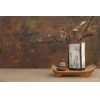|
 The design
of interior is the aspect that everyone can choose subject on their
preferences, emotions and budget. Some designers occasionally attach eastern
accessories into the western design of the interior and the whole picture looks
ideal. Currently there is a tendency to add some Japanese style accessories
into the European style interior. It is sometimes done due to sincere concern
in the Japanese culture, and in other cases - just because of illogical sentiment
when the things are perceived but unfeasible to be explained. The design
of interior is the aspect that everyone can choose subject on their
preferences, emotions and budget. Some designers occasionally attach eastern
accessories into the western design of the interior and the whole picture looks
ideal. Currently there is a tendency to add some Japanese style accessories
into the European style interior. It is sometimes done due to sincere concern
in the Japanese culture, and in other cases - just because of illogical sentiment
when the things are perceived but unfeasible to be explained.
The
Japanese style interior is light and easy and functional at the same time, it
is like a shield that absorbs the fussy life elements from the outdoor
preventing from going inside.
The Japanese style is similar to minimalism.
The same as above, its concept
is that unnecessary things and accessories look ugly and do not work. It offers
built-in furniture that conceals clothes and books, instead. Quite modern
wardrobes are complemented with special niches in the walls that serve to order
the things sited, and achieve the natural look of the accommodation. By the Japanese
policy, the place for relaxation should be in the center of the room. As a rule,
it is the Japanese mattress futon from cotton. This is a perfect bed that is
very comfortable and «easy to disassemble». Light wooden compartments «sedzi» with
the matte glass built-in the frame door are widely practiced in the European
design of interior. This is very easy way to separate the banquette hall into dozens
of cozy places, or equip the large conference-hall with separate rooms.
Mobility is
the first and major benefit of the Japanese furniture, traveling portable trunks
and light cupboards. However, the Japanese antique furniture may appear luxury
and imperial as well as the other furniture. When it is made from the fine wood,
polished, decorated with smithery work, and early affordable by the nobles
only, it is worth thinking and acquiring, even if you are not collectors but
middle-class people who appreciate this stuff.
Eastern colors
look and appear more immediate than western colors, like creamy, red, golden
and some black color. Warm shades and natural materials perfectly match each
other and the interior, particularly golden shreds, terra-cotta clay bricks, bamboo,
carpet covering on the jute base.
Fir wood hinoki
and cedar sugi are widely practiced to manufacture furniture in Japan.
The adjacency
of the Japanese interior to the nature is uttered not only in natural colors
and materials used, but also in the capacity to change.
The Japanese
designers set the rule to juggle with several «must have» decorative items that
are shifted or replaced involving the House as the member of the family in
celebration of events or holidays. Such a serious activity as the design of
interior for housing is deemed as the game when light and elegant shields are
used. Japanese people do not tend to separate room for everuse. Instead, they zone the space with multi-level floors,
shields and screens. Shaded light, covering the home from inside is the member
of the family with all rights as well. The light disperses due to the Japanese
lampshades from rice paper, that slightly highlighting the significant pieces. Yet,
all the things are significant in the Japanese housing to some extent since the
Japanese do not prefer things of mass manufacture. The ideal thing in the
Japanese concept is when it is unique and does not have copies and analogues in
the world.
The concept
of the nature appeared in the housing design owing to tsunami and typhoons that
the Land of the Rising Sun is prone to. The «live» housing that acts in harmony
with the nature brings the feeling and perception of the outer world free from
disasters and it is believed a good solution to please the nature in such a
sincere way.
The
interior accessories used by Japanese designers come as vases, paper fans with
the Japanese cherry tree branches prints, statues of netsuke, wooden dolls, magnificent
china ware, and dwarf bonsai saplings. Bonsai saplings in China were grown by the Buddhist monks
considering this hobby as the spiritual practice to achieve perfection, while
in Japan
this hobby was adopted by the emperors in the 12th century. The philosophy
and esthetics of the bonsai is quite complicated since every bonsai sapling or
the homemade «on the tray» bonkeyi landscape symbolizes some virtues or exemplifies
the wise principles aphorism.
Just bear
in mind that Japanese pieces of furniture are fairly decorative though you
should not abuse with it. You may also acquire the perfect linen with
hieroglyphs or the table ware for tea ceremony or the set for roll cooking,
though you'd better remember that the best is the enemy to the good.
The
Japanese style of interior is not just accessories and decoration as such; this
concept includes light, air, and space, warm and kind concern in the world and
to you.
Japan is also the country of high
technologies, thus, the geographic inconsistency of the Japanese minimalism
does not conflict with the shining chrome pieces made in high-tech style. The
Japanese who afford and widely use the western approach to various aspects of
life (remember Murakami) still have the interior design in the traditional
style called «vasitsu». This is the room that does homage to the roots and
national traditions. On the top of it, the space is perfect for tea ceremonies
or meditation lessons.
|